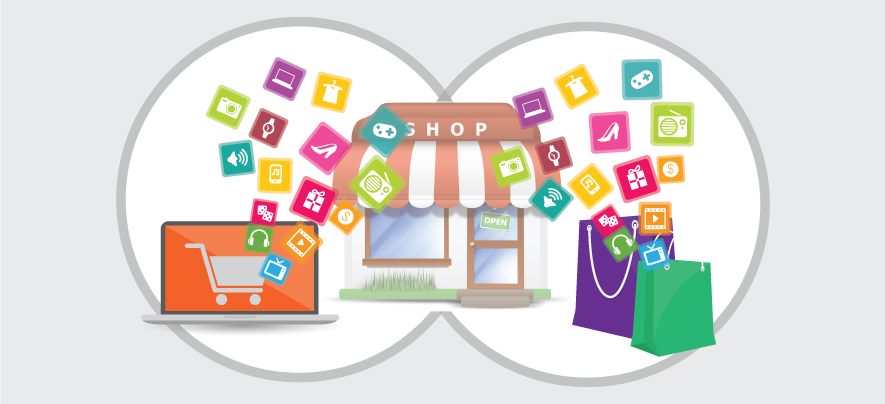The Brick & Click Synergy

Ecommerce
558 week ago — 18 min read
Co-existence. It’s a theme which has not been explored by the “E-tail v/s Retail” debate. That’s because the “E-tail v/s Retail” debate started in saturated markets such as the US and the UK. In an Indian context where the consumption wave is expanding the overall market size – this debate needs to be contextualized to refocus on a “Brick and Click” synergy.
A Google India-Nielsen ‘Tech Shopper’ study conducted in 2012 found that more than 40 per cent of the in-store purchasers in metros, Tier I and II cities undertake online research before making a decision. Consumers have begun to ‘converge’ e-tail and retail in the way they buy – it’s time for retailers to do the same.
STORAI spoke to four powerful brands –Croma, Ferns & Petals, Titan, and Hidesign, about how they are exploiting this synergy.
- Croma – Capturing Brand-share
“We ventured online (www.cromaretail.com) because there were many towns where we were not physically present; but where there was a strong brand recall – because Croma is a TATA enterprise. We’ve found, that our physical network of 100+ stores has strengthened our online positioning.” - says Ajit Joshi, MD & CEO, Infiniti Retail Ltd (the company that owns the Croma brand).
Strategically, Croma online is positioned as an extension of the company’s tag line: - “We help you buy”. Online store operations are geared around ensuring brand-consistency and operational ease – “We have strict turnaround times for all online orders – this creates low returns” – says Ajit, “Although customer expect discounted prices online – we offer the same prices in both channels.” For brick and click retailers, this is important to ensure that channel cannibalization does not happen.
“Another area of focus for us is brand consistency. All marketing communication is branded to include both channels – and the company uses digital marketing extensively including a product blog and email campaigns.” – says Ajit. The blog is targeted at the “techie” customer (it’s written in ‘techie-ese’) – consumer research showed that most customers researched product features online, understood and were comfortable with the associated jargon
Croma has also pioneered the first true example of Omni-channel retailing in India. Called “OOPS” – Order Online and Pickup from Store, it allows the customer to select a store based on pin code mapping after placing an online order. The customer can pick up her purchase at the chosen store - within 48 hours of placing the order. OOPS is targeted at the time-starved, urban affluent and is popular for high traction categories such as iPhones, iPads, smartphones, and Tablets. The model also ensures lower RTO (Return to Origin) rates. That’s a key factor in channel profitability – unlike their e-tail counterparts, Croma has turned each store into a delivery centre for the online channel – this ensures that the two channels do not compete with each other.
The online model has not been without its challenges – some operational and some perceptual. Ajit says, “We’ve dealt with teething problems ranging from website security, managing backend & logistics, ensuring secure financial transactions and settlement with the banks. In the online space, typically the Indian consumers expect lower prices. However at Croma, the prices are the same in both the models.”
In tackling these challenges, Croma believes that the ‘steady-state’ for the online state is about Rs 20 cr per month – i.e. a 6x growth factor.
Impact Zone: Croma’s 25,000 daily site visitors spend between Rs 4,000 and Rs 5,000 per cash memo – and account for monthly sales of Rs 3 cr. Growth rates are high – 100% y-o-y, partly explained by the low base. - Utsav’s ambitious flight
At the opposite end of the spectrum – Utsav Fashion has one physical store at Jaipur and most of its Rs 100 cr plus turnover is from online sales.
“Our vision is to dominate the global market for Indian Ethnic Fashion – so, our physical retail presence is incidental. It acts as an aggregator for sourcing and for us to understand customer tastes, design preferences and service requirements from face to face interactions. Our goal is to be a Rs. 500 Crores company in the next 3 years.”, says Pradeep Katiyal, CEO, Utsav Fashions
The company has been selling online for more than a decade. Online enables them to delink design from inventory. The website offers more than 50,000 designs online - an “endless aisle” concept.
“The entire look and feel of the website is based on a customer’s buying thought process – design curiosity and queries.”, says Pradeep.
The e-store and the physical channel ‘feed’ off each other. The physical store provides reassurance to the NRI customer who visits India during the Christmas/ New Year holiday, when Jaipur is a key tourist destination – and acts a conduit for vacation and occasion shopping. The online store provides access and world-wide shipping – ensure repeated purchases for the NRI / overseas customer who wants ethnic Indian wear.
“Utsav Fashion works closely with the relevant tourism associations in Jaipur. This enables tourists from across the globe to shop from our offline store in Jaipur. They go back with the confidence that they can continue to get Ethnic merchandise in their own countries from our online operations” , says Pradeep.
The final link in the chain is technology: Initially, innovation was about navigation on the website and grouping of products by occasion rather than garment category. In the last 12 months, Utsav has included video shopping, social shopping and mobile shopping features. “Utsav ‘s website is mobile-optimized and the company will soon launch mobile apps for Android and iPhones” , says Pradeep.
Other innovations include:An easy to use online custom-tailoring platform called UDesign, which offers a simple 3-step customization – Fit, Style & Adornment, and instant access to 5000+ design combinations
-
-
- Utsavpedia is an encyclopedic detailing of the myriad forms of Indian Ethnic Fashion, with the objective of educating, and celebrating Indian ethnic clothing.
- U'Signaturr - Designer wear – created by the in house “Fashion Gurus” of Utsav Fashion based on the concept of “Indo-Western” fusion
- UDrape, a video platform to help customers understand the art of Saree draping.
- Utsavpedia is an encyclopedic detailing of the myriad forms of Indian Ethnic Fashion, with the objective of educating, and celebrating Indian ethnic clothing.
-
- Ferns & Petals (*&P) online journey
Ferns & Petals (*&P) – www.fnp.com - was set up in 1994 and with a vision of delivering flowers across India. The initial days were difficult, rentals were high and flowers perishable. A chance befriending of an employee of TajLands End, led to promoter VikaasGutgutia changing his business model. A chance befriending with an executive from Taj Palace Hotel in Delhi, in 1997, changed the fledgling entrepreneur’s business model. The company won the contract to supply flowers for a wedding at the hotel, creating what continues to be FNP’s largest and most profitable segment. Excess flowers from the physical store started getting utilized—a source of synergy and cost saving. The company deepened its offering in the wedding / party market by offering not just flowers but end-to-end solutions including lighting, seating, and decoration. This was the segment which also helped build the *&P brand – high profile weddings are natural aggregators of the rich and the famous, especially Delhi’s social elite.
Through the 1990’s the company continued to expand its store network. Key strategic constraints to be managed were the supply chain and ensuring standardization of delivered product - the bouquet delivered needed to look as fresh as its catalogue counterpart.
To control the supply chain of flowers, the company set up a wholesale trading division; to regulate design, it learnt the craft, by importing skilled artisans from West Bengal; and to monitor scare, it set up systems and MIS. It was one of the few organized players in the Rs 2500 flower market (source: Forbes, Aug 2013) to achieve scale and standardization. “There are other florists but *&P is the only one who has built scale in the business,” says fashion designer TarunTahiliani who has partnered Gutgutia to set up designer flower stores, FNP Tahiliani.
In 2000, the company set up its online business –to cater to the need of the overseas community’s need to gift family and friends in India. The online business created pricing power and acts as an aggregator – driving orders to owned and franchised stores. About 25% of franchised orders are via the online site – a source of synergy between brick and click. “For example, if there is an order to be delivered in Bhilai, our ecommerce department places the order to the franchisee in Bhilai and they deliver the order. This way both the company and the franchisee work hand in hand to do the business.”, says CEO Pawan Gadia.
Site navigation was reset (with significant investment in technology, after the first technology platform didn’t succeed) so that availability drives range suggestions to customers. “For example, oriental lilies are not available in Patiala and so we do not showcase the online delivery option of oriental lilies in Patiala.” , says Gadia.
The company has extended physical reach through the concept of –express stores – using a franchisee model. It is also franchising its wedding event designs to tier II /III markets. “We also ensure ‘Karigars/ Malis’ are centrally trained (through *&P’s design school, to maintain the brand’s standard. We have centralized warehouse for dispatching items which are uniformly used in the floral boutiques of Ferns N Petals.”, says Gadia.
Scale has been pursued but not at the cost of profitability. Says Gadia, “We have mastered the art of turning outlets profitable”. From the retail network today, 100 outlets are profitable, 20 are “on par” and another 20 are “struggling”, he says. Six months is the average time for an outlet to break even; if it doesn’t do so within a year, it is shut down.
The company is experimenting with variants of the Cash of Delivery (COD) model – customers can pay at the retail store, having ordered via the call center. Growth plans (in the ‘brick’ channel) include setting up stores in Kathmandu and Dubai and growth plans in the online space include making the site mobile enabled and launching apps to enable customers to buy off their smart phones. - Hidesign’s e-commerce endeavors
Among the retailers surveyed by STORAI, Hidesign ‘s online business is nascent – accounting for about 7% of its topline. The company has been present in the online space since 2009 but had adopted a ‘scouting option’ approach – i.e. maximum impact with minimum investment. The website was initially used to create brand awareness especially in the Tier 2 and Tier 3 cities, and morphed into an ecommerce portal about a year back. The online channel offers the standard COD, ‘track your order’ and free shipping functionalities. The company is planning a strategic tie up in 2014 with a specialist e-commerce company as a means to attract higher traffic.
“We redesigned the site ensure that designs and catalogues are updated on regular basis. We have increased the investments in online marketing and digital marketing channels.” says Dipen Desai, Brand Manager, Hidesign.
The company has also aligned the online and offline channels: “We have introduced a new section on the website, which features new store launches and product placement in print, online and electronic media.”, says Dipen, adding that “Our in-house design team ensures that product placement pages are kept updated not just on our portal but also on the marketplaces where we are listed. The focus is on maintaining the premium positioning of the brand”.
The biggest challenge the company has faced has been traffic: in an online context customers are habituated to ‘deal based’ shopping, which the brand’s premium positioning precludes. Educating the online customer to focus first on design rather than price is a key focus area for this brand. At the same time, online allows the brand to showcase design and endless range options.
“Hidesign as a brand has a lot of depth in terms of styles. The website allows us to showcase our design and styling options. We also use the social media to draw traffic. We have invested in decreasing shipment timelines and are working on improving our response mechanisms. Reliable logistics and supply chain is very important to ensure the virtual store is successful. We are planning to invest in a new warehouse to manage online inventory as well.” , says Dipen
Innovations including integrating the online channel into its loyalty program and selling gift cards, as well as increasing online presence by listing on market-places.
- Titan Online
Titan is a powerful offline brand. In the last 20 years the company also has a successful track record of building a portfolio of brands – e.g. Tanishq, Fastrack, Raaga, Sonata, Titan Eye Plus and most recently Titan Skin. The brands were built as independent businesses in the brick and mortar space. In the online world they are retailed off one platform. While this creates powerful range aggregation; titan.co.in retails 6000+ products across categories like-jewellery, watches, accessories, eye wear, bags, sunglasses and fragrances – it also introduces challenges when it comes to supply chain and fulfillment.
“Titan Company’s ecommerce portal has been launched about 6 months back. It is early to comment on percentage of top line sales etc. We believe that digital will have significant role play for us and the retail industry in the future. Having said that, online retail is an evolving business in India, and we are in ‘learning mode’ ” explains Alokedeep Singh, Head, E Commerce Titan Company.
While titan.co.in seems like a vertical portal – in reality it is a mini-marketplace. It was essential to create unique brand and shopper experiences . Alokedeep says, “As the e-store offers products, across our brands like Tanishq, Fastrack, Titan, Sonata, Titan Eye+ & more, the imagery, catalogue, banners, communication are in line with our Brand campaigns to maintain consistency in consumer’s experience”.
A key area of focus is ensuring synergy between ‘brick’ and ‘click’. “Besides the brand experience, product range, pricing and offers have been kept consistent across both channels. The idea is to offer consumers a similar shopping experience on the channel of their choice/liking.” Given the products sold are high involvement purchase, the online channel drives traffic to the physical store.
The online channel sees about 20% of traffic from mobiles – something that the company has taken note of. Future growth plan revolve around enhanced integration between both channels and moving to a omni-channel model.
If you intend to Brick and Click then think....
- Pricing: Online customers display a high degree of bargain shopping or deal based purchase. For brick and mortar retailers – the online channel is about enhancing reach NOT differential pricing. Differential prices across owned channels (online and offline) only serves to confuse the customer and dilute the brand.
- Reach: Almost all brick and mortar retailers under-estimate the supply chain challenges that online brings. Having a supply chain which handles physical stores does not prepare them for the challenge of having to deliver anywhere in India.
- Omni channel - Brick and mortar retailers need to first master online and then aim for Omni-channel. Back end inventory management and returns management processes can break down unless this transition is carefully handled.
- Cross – pollination: Done right, online can and does drive traffic to stores. But it can also dilute the in-store experience. Front end staff have to be trained to prepare them for customers who can and will whip out their smartphones and ‘showroom’ the transaction.
This article has been republished from STOrai Magazine
Network with SMEs mentioned in this article
View STOrai 's profile
SME Inspirations
Other articles written by STOrai Magazine
The Art & Science of People Pleasing in Retail
26 week ago
Most read this week
Trending
What is BRC in Export Business?
Export Sector 1 week ago
















Comments (1)
Share this content
Please login or Register to join the discussion